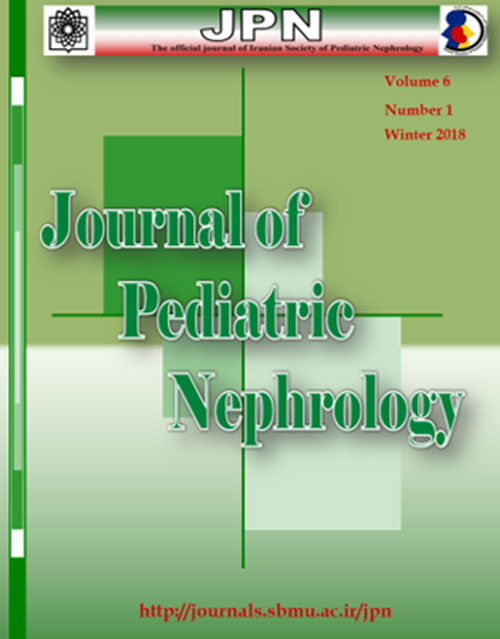فهرست مطالب

Journal of pediatric nephrology
Volume:6 Issue: 1, Winter 2018
- تاریخ انتشار: 1397/03/06
- تعداد عناوین: 6
-
Page 1IntroductionPediatric urolithiasis is a morbid condition that is often associated with underlying metabolic disorders. It is essential to diagnose and manage the underlying metabolic disorder along with management of urolithiasis to prevent stone recurrence and decrease the morbidity.Materials And MethodsThis retrospective observational study was conducted in 50 patients below 15 years of age with urolithiasis. Urine collection was done for 24 hours in toilet-trained children and spot samples were taken from younger children. The urinary parameters that were evaluated included calcium, oxalate, citrate, uric acid, and total urine volume. The serum levels of calcium, phosphorus, creatinine, uric acid, electrolytes, parathormone, and albumin were also measured. Stone analysis was done whenever possible.ResultsThere were 32 males and 18 females. Sixty-two percent of the patients had a low calcium intake and 70% of the children had a history of low water intake and had a low urine volume over 24 hours. Half of the children had serum metabolic abnormalities, including hypocalcaemia (n=19,38%), hypocalcaemia with hyperphosphatemia (n=2, 4%), hypercalcemia (n=2, 4%), and hyperuricemia (n=2,4%). Urinary abnormalities were detected in 42% of the children (n=21). These abnormalities included hypocitraturia in 11 patients (50%), hypercalciuria in 7 patients (30%), hyperoxaluria in 1 patient (6%), and hyperuricosuria in 2 patients (12%). Stone analysis was done in 18 patients. Fifteen patients (30%) had calcium oxalate stones, two patients (4%) had uric acid stones, and one patient had a mixed stone.ConclusionsIt is important to maintain an optimal blood calcium level and increase fluid intake to prevent stone formation in children.Keywords: Urolithiasis, Pediatric, Metabolic Disorders
-
Page 2IntroductionPrimary enuresis is the most common elimination disorder in children and adolescents aged 5-17 years worldwide. It often results in psychological, social, and financial problems. This disorder is understudied in less affluent countries.ObjectiveThis study was done to assess the prevalence and associated factors of primary enuresis in children and adolescents in Bahir-Dar Town, Ethiopia.Materials And MethodsThis cross-sectional community-based study was conducted in children and adolescents from May to July 2016. A total of 1547 subjects were selected using a multistage sampling technique. Data were collected using DSM-5 criteria and the Strengths and Difficulties Questionnaire (SDQ).ResultsA total of 1520 participants were involved in the study with a response rate of 98.25%. The prevalence of primary enuresis was 8.6%. Age range 5-8 years [AOR=10.35, 95% CI (3.468, 30.875)], deep sleep [AOR=2.18, 95% CI (1.192, 3.983)], and conduct problems [AOR=5.98, 95% CI (3.341, 10.694)] were significantly associated with primary enuresis.ConclusionsFactors that affect primary enuresis are young age, deep sleep, snoring during sleep, sleeping more than two hours a day, and conduct problems. Therefore, special attention should be given to children and adolescents about primary enuresis prevention.Keywords: Primary enuresis, Child, Adolescent
-
Page 3IntroductionGuidelines suggest a biopsy-tailored treatment rather than glucocorticoids as initial therapy for adolescent-onset nephrotic syndrome (NS) as minimal change disease is more common in younger children. There is a paucity of data regarding the clinical course and renal histopathological findings in this population. This study analyzed the clinical course and histological spectrum of adolescent-onset NS.Materials And MethodsIn this retrospective study, we evaluated the medical records of patients with adolescent-onset NS who received treatment at the Department of Pediatrics, SVPPGIP & SCB Medical College, Cuttack, Orissa, India, between January 2010 and January 2017. Patients with congenital, infantile, childhood-onset, and secondary causes of NS were excluded. All children were treated as per the Indian Society of Pediatric Nephrology (ISPN) protocol.ResultsThe data of 48 adolescents were analyzed. The median age at onset of disease was 12 years (range: 10-14 years), and 68.75% (33/48) of the patients were males. Steroid-dependent NS (SDNS, 43.7%, 21/48) was the most common indication followed by frequently relapsing NS (FRNS, 29.1%, 14/48). Prednisolone with tacrolimus (37.5%, 18/48) and mycophenolate mofetil (35.4%, 17/48) were the most commonly used treatments. Biopsy results showed that minimal change disease (MCD) was the most common histopathological subtype (37.5%, 18/48) closely followed by focal segmental glomerulosclerosis (FSGS, 31.2%, 15/48). Most of the cases responded to a combination of prednisolone and MMF, cyclophosphamide, or tacrolimus (23%).ConclusionsThe most common underlying cause of adolescent-onset nephrotic syndrome as assessed histopathologically is MCD, closely followed by FSGS with most of the cases responding to a combination of prednisolone and mycophenolate mofetil, cyclophosphamide, or tacrolimus.Keywords: Nephrotic Syndrome, Adolescent, Treatment
-
Page 4IntroductionChildren with frequently relapsing nephrotic syndrome (FRNS) frequently develop adverse effects of prednisolone and attempts to induce long term remission in such patients have varying degree of success.Materials and MethodsWe conducted a randomized clinical trial in a tertiary care level hospital to compare the efficacy and safety of a 1 year treatment with mycophenolate mofetil (MMF) and Cyclosporine (CsA) in 60 pediatric patients with FR-SSNS during one year period. We assessed the frequency of relapse as the primary end point and evaluated clinical and laboratory profile after 3 and 6 months of treatment.ResultsMean number of relapse was 1.50 ± 1.44 in MMF group and 0.72 ± 1.30 in CsA group at 6 months (p=0.045). Diarrhoea was statistically significant in MMF group. Hypertrichosis & hypertension were statistically significant in CsA group. There was no significant difference between groups with Hb levels, lipid profile, eGFR.ConclusionThe result of the study showed MMF is inferior to CsA in preventing relapse in patient with FRNS but less nephrotoxic.Keywords: Cyclosporine. Frequently relapsing. Mycophenolate mofetil. Nephrotic syndrome
-
Vancomycin Induced Eosinophilic Peritonitis, A Case ReportPage 5Drug induced peritonitis is a rare but important complication in CAPD. Hereby, we report on a case that developed esosinophilic peritonitis during intraperitoneal prescription of vancomycin. With suspicious to vancomycin induced eosinophilic peritonitis, vancomycin discontinued. Antihistamine medication started and the PD effluent two days after stopping medication revealed 85 WBC (10% Eosinophil, 71% Lymphocytes). The systemic sign improved dramatically in less than a week. In conclusion, Drug induced peritonitis should be considered in different diagnosis of each patient on CAPD before considering administering another new antibiotic.Keywords: Vancomycin, Peritonitis, Allergy, Immunology

